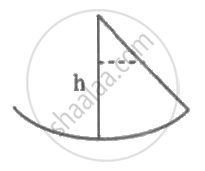Advertisements
Advertisements
Question
A thin, uniform metal rod of mass 'M' and length 'L' is swinging about a horizontal axis passing through its end. Its maximum angular velocity is 'ω'. Its centre of mass rises to a maximum height of ______.
(g =acceleration due to gravity)
Options
`(L^2omega^2)/(3g)`
`(L^2omega^2)/g`
`(L^2omega^2)/(2g)`
`(L^2omega^2)/(6g)`
MCQ
Fill in the Blanks
Solution
A thin, uniform metal rod of mass 'M' and length 'L' is swinging about a horizontal axis passing through its end. Its maximum angular velocity is 'ω'. Its centre of mass rises to a maximum height of `underline((L^2omega^2)/(6g))`.
Explanation:

mgh `=1/2Iomega^2`
`I="mL"^2/3`
`therefore"mgh"=1/2("mL"^2/3)omega^2`
`"h"=1/(6g)L^2omega^2`
shaalaa.com
Vertical Circular Motion
Is there an error in this question or solution?
